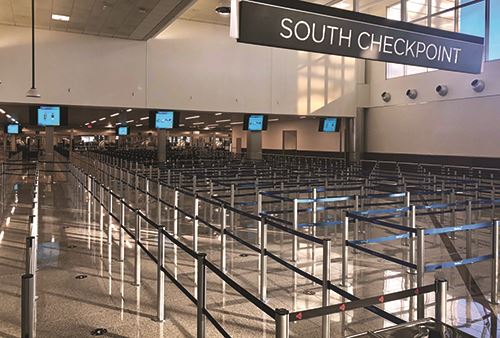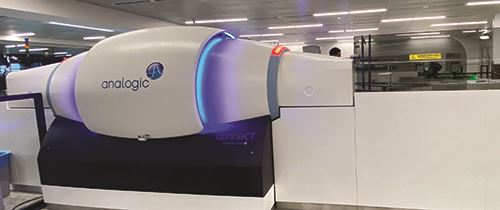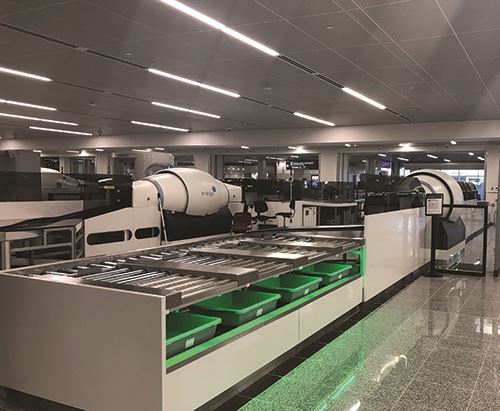In 2019, Hartsfield-Jackson Atlanta International (ATL) was the world’s busiest airport—hitting an all-time high of 110 million passengers. To increase throughput and maintain its service level agreement of less than 20-minute wait times for passenger screening, ATL added five new lanes to its South Security Checkpoint.
In 2019, before COVID brought air travel to a trickle, Hartsfield-Jackson Atlanta International (ATL) was the world’s busiest airport—hitting an all-time high of 110 million passengers. With that sort of traffic, TSA checkpoints are bound to be a pinch point. So to increase throughput and maintain its service level agreement of less than 20-minute wait times for passenger screening, ATL added five new lanes to its South Security Checkpoint. Now, that area has nine, the North Security Checkpoint has five and the International Checkpoint has 15.
 ATL General Manager Balram Bheodari explains that the recent project wasn’t just about making room for more lanes and queuing space. It was an opportunity to use cutting-edge technology to increase throughput, cut wait times and increase security. As the first U.S. airport to have automated screening lanes back in 2016, ATL has a history of embracing innovation to keep visitors and employees safe.
ATL General Manager Balram Bheodari explains that the recent project wasn’t just about making room for more lanes and queuing space. It was an opportunity to use cutting-edge technology to increase throughput, cut wait times and increase security. As the first U.S. airport to have automated screening lanes back in 2016, ATL has a history of embracing innovation to keep visitors and employees safe.
Risk vs. Reward
Tom Nissalke, the airport’s assistant general manager for planning and development, notes that Atlanta’s Department of Aviation partnered with TSA and Delta Air Lines to make it happen.
As the project was developing, Jason Hausner, managing director of passenger facilitation for Delta, worked closely with the Innovation Task Force at TSA headquarters to stay abreast of the latest developments in technology. “Delta is very forward leaning and innovative in the approaches we take for the customer touch points that we can control,” Hausner explains. “We want to influence both TSA and CBP to make our customers’ experience at the checkpoint safe and secure, but with the least amount of wait time as possible. And that’s mostly done through innovative technology.”
|
Project: Checkpoint Expansion Location: Hartsfield-Jackson Atlanta Int’l Airport Owner: City of Atlanta Dept. of Aviation Cost: $42.2 million Funding: General airport revenue bonds Timeline: Team received Notice to Proceed in mid-March 2020; project was substantial complete in mid-Nov. 2020 Delivery Method: Design-bid-build Contractor: New South-Synergy (a joint venture) Size: 30,000 sq. ft. Scope: Doubled size of South Security Checkpoint area by adding 5 screening lanes, new TSA offices & breakrooms, a breach control unit, employee Interlock unit, training rooms & remote screening room Automated Screening Lanes: L3Harris’ Macdonald-Humfrey Mach-SmartLane™ Gen2 Automated Screening Lane (ASL) Scanners: Analogic’s ConneCT™ Computed Tomography (CT) Checkpoint Screening System Of Note: First U.S. airport to fully integrate computed tomography & automated screening lane systems |
Based on those discussions and other explorations, ATL elected to integrate computed tomography and automated screening lanes—something no other U.S. airport had done. The system combines L3Harris’ Macdonald-Humfrey Mach-SmartLane™ Gen2 Automated Screening Lanes (ASL) and Analogic’s ConneCT™ Computed Tomography (CT) Checkpoint Screening System.
Brian Morris, program analyst for TSA at the airport, notes that ATL accepted some risk by choosing technology that hadn’t yet been fully approved by TSA. If the vendor or technology was ultimately not approved, the airport could have been asked to remove the equipment at its expense.
But that was a calculated risk ATL was willing to take. “We and the TSA have performed a lot of research and development together on this type of technology in the field,” Nissalke says. “We can’t say enough about our local TSA, and what great partners they are—not only in day-to-day operations, but when it comes to trying something new. They’re always open to do what is best for the operation, and it’s been that way for the last 15 years, ever since the TSA was created and started operation here in Atlanta.”
Integration & Innovation
The first order of business was finding space to expand the checkpoint footprint. Delta pitched in by relocating some of its back-of-house offices and an employee breakroom to help clear the way.
Beyond adding new lanes, the project significantly increased the checkpoint’s queuing area. This reduces crowding of passengers as they wait to be screened—a protocol that has become increasingly important as the pandemic continues. The entire area also received all new finishes, such as tile flooring, metal ceilings, storefront partitions, signage and new granite wall tile.
The second-generation Macdonald-Humfrey automated screening lanes offer two key enhancements: On the front end, four passengers can place their items in bins at the same time and quickly access additional bins if needed. The machine automatically sorts and distributes the bins based on which passenger pushes his or her bin forward first.
On the back end, the system automatically returns bins for use by the next passengers. This feature not only frees up TSA officers from gathering and moving bins, it also analyzes each bin to make sure it’s empty before returning it to the front of the line. “The TSA really likes both of those features because it’s less wear and tear on our operators, and it makes it more efficient for the passengers,” Morris remarks.
The other crucial component of the integrated system is computed tomography—the same technology used for medical imaging. The eight Analogic ConneCT™ scanners at ATL’s South Checkpoint create high-resolution 3-D images of everything in passengers’ bags. Each scanner uses thousands of X-ray sensitive detectors and sophisticated detection algorithms to identify potential threat items in carry-on bags being run through the scanners.
“You can rotate the image on all three planes and then zoom in and out,” Morris explains. “Additionally, the machine itself has all of the required algorithms to automatically identify what it thinks our officers should be looking at—whether it’s a shield or high-density metal, or explosives.” Due to the sophistication of the 3-D imaging, customers don’t have to take anything out of their bags, including electronics, approved liquids and toiletries. This increases convenience and throughput.
 “Integrating the two parts of the system allows screening agents to get a much more comprehensive view of the items they are scanning,” Nissalke says. “Not only is it more secure, but the computing power of the scanners is much greater; so operators can look at and make a determination of the image faster than with legacy equipment.”
“Integrating the two parts of the system allows screening agents to get a much more comprehensive view of the items they are scanning,” Nissalke says. “Not only is it more secure, but the computing power of the scanners is much greater; so operators can look at and make a determination of the image faster than with legacy equipment.”
According to Delta personnel, passengers are moving through ATL’s South Checkpoint nearly 20% faster than before the new technology was deployed. And Bheodari reports that customers rave about the speed and ease of navigating through the new hassle-free system.
A representative from TSA’s media department notes that enhanced security is the first consideration with new checkpoint technologies. TSA maintains strict performance requirements that added technologies must first significantly enhance security; the benefit of efficient screening and the passenger experience are important additional features and considerations, he adds.

Checkpoint Enhancements
The eight checkpoint property screening system lanes consist of eight new CT machines, five new Gen2 Mach-SmartLane ASLs and three Gen1 units retrofitted to the same Gen 2 Mach-SmartLane ASL configuration. Each lane is roughly 72 feet long and 6 feet wide.
Morris counsels other airports that are interested in installing a similar system to make sure they have enough space for at least four divest positions and eight recomposure positions. Shortening the layout too much hampers efficiency, he warns.
ATL created space for more lanes and ample TSA support areas. The renovated South Checkpoint includes manager offices, a training room, a breakroom and locker room—all co-located with the nine-lane screening area.
A close-circuit TV system has overlapping high-definition cameras that literally cover every inch of the checkpoint. “That is so critical for us in any investigations that we want to do while partnering with the airport,” Morris says. “We’re able to pull video, and it’s just a world of help.”
With the new equipment in place, TSA continues to refine the networking capabilities of the Analogic CTs. Cross-lane capabilities at all checkpoints will allow any image from any CT lane to be sent to the next available TSA officer so he or she can evaluate it. This leverages any downtime an officer may have while waiting on the next bin to be input for screening.
Remote capability also will allow the officers evaluating CT images to be located in a dedicated screening room away from the checkpoint. “We are seeing great efficiencies applying this networking technology to an already fantastic imaging system,” Morris says. “When passenger volume is really heavy and all lanes are in use, adding additional remote operators reduces screening time.”
To help TSA officers become familiar with the new technology, Analogic provided five simulators—computers loaded with the same type of images officers would encounter once the machines were in place. Training began at TSA headquarters and then transitioned to ATL as the machines were installed and certified. After COVID hit, the airport shut down its entire South Security Checkpoint for a little more than 12 months, which provided officers the rare opportunity for additional hands-on training without slowing passenger traffic.
Fast-Tracking Construction
As it did for many other 2020 projects, the COVID-19 pandemic provided a few extra plot twists at ATL. Although construction and training had to be shut down several times after workers tested positive for the virus, the highly unusual circumstances mostly worked to the airport’s advantage.
In fact, the project team took advantage of dramatically reduced passenger traffic to reassess its phasing schedule. Initially, the plan was to build the five additional lanes, and then go back and retrofit the four existing lanes with new equipment.
“After we spent time discussing it with the TSA and Delta, we decided to collapse it into a single phase,” Nissalke explains. “That gave our contractor team the entire site to work with, which resulted in a much more efficient project execution.”
The revised strategy was so streamlined, crews completed the job four months ahead of schedule. Much to management’s delight, the newly updated checkpoint opened just before Thanksgiving 2020.

Over the Finish Line
The accelerated timeline was also made possible by help from Delta and TSA. Delta flew the automated screening lane equipment across the Atlantic so it didn’t have to be shipped by boat—a move that saved several months. TSA worked closely with U.S. Customs and Border Protection to secure special permission for Macdonald-Humfrey technicians based in the U.K. to enter the U.S. to help install it. Because this was the first installation of its kind in the U.S., manufacturer support was especially important.
Hausner notes that constant communication in the form of contractor meetings, stakeholder updates and daily briefings allowed the project team to work through issues as they popped up and keep the schedule on track.
“Collaboration is key,” he emphasizes, “including ongoing collaboration with our government partners, TSA and CBP, as well as a strong partnership with our host airport and department of aviation. This was not just a construction project. It was also a passenger facilitation project where you’re trying to move customers through the government channel as quickly and easily as possible. So having a collaborative group of stakeholders who understand that vision really paved the way for us to get it done in the allotted timeframe.”
Another important behind-the-scenes partner was the RCA (Requirements, Capabilities and Analysis) Team from TSA headquarters. It helps foster public/private partnerships to demonstrate, test and analyze new technology solutions like the CT system installed at ATL. The team’s findings help inform future requirements for purchasing, deploying, integrating and operating such equipment.
Morris notes that TSA is also using ATL’s enhanced checkpoint to evaluate non-material solutions such as new data collection strategies, concept of operations revisions, standard operating procedure adjustments and training enhancements. He adds that the federal agency is always looking for ways to optimize future security equipment and increase the technology readiness level of airports.
From Bheodari’s perspective, ATL couldn’t have asked for a better outcome. “The team was on its ‘A game’ in the delivery of this project,” he concludes. “The planning and design was comprehensive and, as a result, there was very little to no omissions once we started construction.”


 facts&figures
facts&figures

